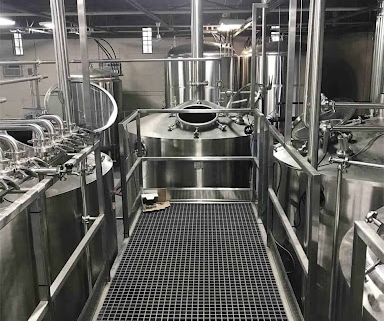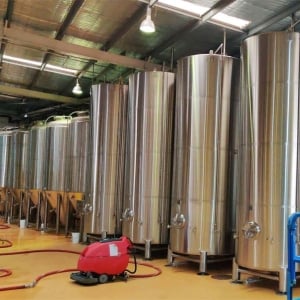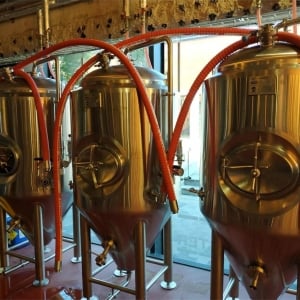brite tank for Sale
Ever dreamt of serving up crystal-clear, perfectly carbonated beer? Then a brite tank might be the missing piece in your brewing puzzle. These polished stainless steel vessels are the workhorses behind the scenes, ensuring your beer reaches its peak condition before hitting the tap. But with a variety of options and factors to consider, navigating the world of brite tanks for sale can feel overwhelming. Fear not, brewers! This comprehensive guide will equip you with all the knowledge you need to find the perfect brite tank for your needs.
Bright Tank Overview
Brite tanks, also known as serving tanks or conditioning tanks, are the final stop for your beer before it’s enjoyed by thirsty customers. After fermentation is complete, your beer is transferred to the brite tank for a few key purposes:
- Carbonation: Brite tanks are equipped with a carbonation stone that infuses your beer with the perfect amount of CO2, creating that signature fizz and enhancing flavor.
- Clarification: Brite tanks allow any remaining yeast or sediment to settle out, resulting in a beautifully clear final product.
- Maturation: Some beers benefit from a period of cold storage in the brite tank to allow flavors to mature and harmonize.
Think of a brite tank as the finishing school for your beer. It takes your creation from raw potential to a polished, professional product ready to tantalize taste buds.

Choosing Your Perfect Match
With an array of brite tanks for sale, selecting the right one requires careful consideration. Here are some key factors to ponder:
- Capacity: Brite tanks come in various sizes, from compact 10-gallon models for small breweries to massive 120-gallon behemoths used by large-scale producers. Consider your production volume and storage space when making your choice.
- Jacketed vs. Unjacketed: Jacketed brite tanks feature an insulation layer and cooling jacket, allowing for precise temperature control during carbonation and storage. Unjacketed tanks are more affordable but require a colder storage environment.
- Material: High-quality, food-grade stainless steel (304 or 316L) is the industry standard for brite tanks. This ensures durability, sanitation, and protects your beer from unwanted flavors.
- Features: Look for features that streamline your brewing process, such as manways for easy cleaning, pressure relief valves, and sample ports for quality control. Some advanced models come with integrated carbonation systems and temperature controllers.
Table: Brite Tank Selection Considerations
| Feature | Description | Importance |
|---|---|---|
| Capacity | Size of the brite tank in gallons | Determines how much beer you can store and condition |
| Jacketed vs. Unjacketed | Presence of a cooling jacket for temperature control | Jacketed offers more precise control but is pricier |
| Material | Type of stainless steel used | Ensures durability, sanitation, and protects beer quality |
| Features | Additional functionalities like manways, pressure valves, etc. | Enhance convenience and streamline brewing process |
Remember, the ideal brite tank should seamlessly integrate into your existing setup and workflow.
Bright Tank Capacity and Space Requirements
Choosing the right size brite tank goes beyond just brewing volume. Consider these additional factors:
- Headspace: Brite tanks require headspace, typically around 25%, to allow for CO2 pressure and foam during filling. Factor this in when determining the usable capacity.
- Available Floor Space: Brite tanks can be surprisingly large, especially for bigger models. Measure your designated space carefully to ensure your chosen tank fits comfortably.
- Future Expansion: If you anticipate scaling up production in the future, consider a slightly larger brite tank to accommodate growth.
By carefully considering these factors, you’ll ensure your chosen brite tank not only meets your current needs but also allows for future flexibility.
Bright Tank Design and Customization Options
While many brite tanks share a core design philosophy, some customization options can tailor the tank to your specific needs. These may include:
- Port Configurations: The number and location of ports for filling, carbonation, sampling, and pressure relief valves can be customized.
- Finish: Some manufacturers offer a variety of finishes, such as a mirror polish for a more high-end look, or a brushed finish for a more industrial aesthetic.
- Legs or Stands: Choose from brite tanks with legs for a raised profile or opt for models designed to sit directly on the floor.
Customization options allow you to fine-tune your brite tank to fit your brewery’s layout and workflow.
Bright Tank Suppliers and Price Range
The landscape of brite tank suppliers is vast, catering to both homebrew enthusiasts and commercial breweries. Here’s a glimpse into what to expect:
Suppliers:
- Homebrew Shops: Many homebrew shops carry a selection of smaller brite tanks (typically under 30 gallons) suitable for hobbyist brewers. These are often unjacketed and may have more basic features.
- Online Retailers: Several online retailers specialize in brewing equipment, including brite tanks. They offer a wider variety of sizes and features compared to homebrew shops, with competitive pricing.
- Brewery Equipment Manufacturers: For commercial breweries, dedicated brewery equipment manufacturers offer a comprehensive range of brite tanks. These typically start at 50 gallons and go up to colossal sizes, boasting advanced features and customization options.
Price Range:
As you might expect, the price of a brite tank varies significantly depending on size, features, and supplier. Here’s a ballpark range to give you an idea:
- Homebrew Brite Tanks (10-30 gallons): $500 – $2,000
- Unjacketed Commercial Brite Tanks (50-100 gallons): $3,000 – $8,000
- Jacketed Commercial Brite Tanks (50-100 gallons): $5,000 – $12,000+
Remember, these are just estimates. It’s crucial to research specific suppliers and models to get the most accurate pricing.
Here’s a table summarizing the Supplier and Price Range for Brite Tanks:
| Supplier Category | Typical Size Range | Price Range |
|---|---|---|
| Homebrew Shops | Up to 30 gallons | $500 – $2,000 |
| Online Retailers | Varied (10 gallons and above) | Competitive; Depends on size and features |
| Brewery Equipment Manufacturers | 50 gallons and above | $3,000+ |
Choosing the right supplier involves balancing factors like price, reputation, customer service, and the specific features you need. Reading online reviews and contacting suppliers directly can be valuable steps in making an informed decision.
Bright Tank Installation, Operation, and Maintenance
Once you’ve welcomed your new brite tank home (or brewery!), proper installation, operation, and maintenance are paramount for optimal performance and longevity.
Installation:
- Brite tank installation is generally a job for qualified professionals. The tank’s size and weight necessitate careful handling to ensure safe placement and connection to utilities.
- Suppliers may offer installation services or recommend qualified installers in your area.
Operation:
- Operating a brite tank involves transferring your beer from the fermentation tank, carbonating it to the desired level, and maintaining proper storage temperature.
- Most brite tanks come with manuals outlining specific operation procedures. Familiarize yourself with these instructions before using your tank for the first time.
Maintenance:
- Regular cleaning and sanitation are essential to prevent bacterial growth and contamination in your brite tank.
- A thorough cleaning regimen after each use is recommended. This typically involves using hot water, specialized cleaning solutions, and proper rinsing procedures.
- Regular inspections of gaskets, valves, and other components are also crucial to ensure the tank functions optimally and safely.
Table: Brite Tank Installation, Operation, and Maintenance Summary
| Task | Description | Importance |
|---|---|---|
| Installation | Placement and connection of the brite tank | Ensures safe operation and proper functionality |
| Operation | Transferring beer, carbonation, temperature control | Produces high-quality, finished beer |
| Maintenance | Cleaning, sanitation, inspections | Prevents contamination and ensures long-term tank health |
By following proper installation, operation, and maintenance practices, you’ll get the most out of your brite tank investment and keep your delicious brews flowing.
How to Choose a Brite Tank Supplier
Selecting the right brite tank supplier is just as important as choosing the tank itself. Here are some key considerations to guide you:
- Reputation and Experience: Look for a supplier with a proven track record in the brewing equipment industry. Positive customer reviews and industry recognition are good indicators of a reliable seller.
- Product Selection: Does the supplier offer a variety of brite tank sizes and features to meet your specific needs? Consider whether they cater to your brewery size and production scale.
- Customer Service: A responsive and knowledgeable customer service team is invaluable. Look for a supplier who can answer your questions, address concerns, and provide ongoing support.
- Warranty and Guarantees: A solid warranty on your brite tank protects you in case of unforeseen manufacturing defects. Look for suppliers offering warranties that cover both parts and labor for a reasonable period.
- Pricing and Transparency: While cost is a factor, avoid prioritizing the cheapest option over quality and service. Compare pricing across multiple suppliers while considering the value proposition of each.
- Lead Times and Shipping: Lead times for brite tanks can vary depending on size, customization, and current demand. Factor in shipping timelines when making your purchase decision, especially if you have specific brewing deadlines.
Here’s a table summarizing the factors to consider when choosing a Brite Tank Supplier:
| Factor | Description | Importance |
|---|---|---|
| Reputation & Experience | Track record in brewing equipment | Ensures reliable supplier with quality products |
| Product Selection | Variety of brite tanks offered | Meets your specific size, feature needs |
| Customer Service | Responsiveness and knowledge | Provides support throughout buying and ownership |
| Warranty & Guarantees | Coverage for defects | Protects your investment |
| Pricing & Transparency | Competitive pricing with clear value proposition | Makes informed purchase decision |
| Lead Times & Shipping | Production and delivery timelines | Ensures tank arrives when you need it |
By carefully considering these factors, you can confidently choose a brite tank supplier who will deliver the right equipment, exceptional service, and value for your investment.
Bright Tanks: Pros and Cons
Bright tanks offer a multitude of advantages for brewers, but it’s also essential to consider any potential drawbacks before making a purchase.
Pros:
- Crystal-Clear Beer: Brite tanks ensure your beer reaches customers with exceptional clarity, enhancing its visual appeal and marketability.
- Precise Carbonation: The controlled CO2 environment within a brite tank allows for perfect carbonation levels, delivering the desired mouthfeel and enhancing flavor.
- Improved Shelf Life: Cold storage in a brite tank helps stabilize your beer, extending its shelf life and reducing the risk of spoilage.
- Streamlined Serving: Brite tanks allow for easy dispensing of beer directly from the tank, simplifying your serving process.
- Professional Appearance: Brite tanks add a professional touch to any brewery, showcasing your commitment to quality and consistency.
Cons:
- Cost: Brite tanks can be a significant investment, especially for larger models with advanced features.
- Space Requirements: These tanks have a substantial footprint, so ensure you have adequate space to accommodate them comfortably.
- Cleaning and Maintenance: Regular cleaning and sanitation are essential for maintaining a brite tank, adding to your overall brewery maintenance workload.
- Not Essential for All Beers: Some styles of beer, such as cask ales or unfiltered lagers, may not necessarily require conditioning in a brite tank.
Table: Bright Tank Pros and Cons Summary
| Advantage | Description | Benefit |
|---|---|---|
| Crystal-Clear Beer | Removes sediment for clear appearance | Enhances marketability and customer appeal |
| Precise Carbonation | Controlled CO2 environment | Perfect carbonation levels for optimal flavor and mouthfeel |
| Improved Shelf Life | Cold storage stabilizes beer | Extends shelf life and reduces spoilage risk |
| Streamlined Serving | Easy dispensing directly from tank | Simplifies serving process |
| Professional Appearance | Showcases commitment to quality and consistency | Enhances brewery’s professional image |
| Disadvantage | Description | Drawback |
|---|---|---|
| Cost | Significant investment, especially for larger models | Requires careful budgeting |
| Space Requirements | Substantial footprint | Needs adequate space for installation |
| Cleaning and Maintenance | Regular cleaning and sanitation | Adds to brewery maintenance workload |
| Not Essential for All Beers | Not required for all beer styles | Consider if necessary for your specific brews |
By weighing the pros and cons, you can determine if a brite tank is the right investment for your brewery. For those seeking to elevate their beer’s clarity, carbonation, and overall quality, a brite tank can be a game-changer.

FAQs
1. Do I need a brite tank for homebrewing?
For homebrewers with limited production volumes, a brite tank may not be essential. However, if you’re serious about achieving professional-level clarity and carbonation in your beer, a small brite tank can be a worthwhile investment.
2. Can I use a brite tank for fermentation?
While brite tanks can be used for cold storage during lagering, they are not designed for primary fermentation. The pressure relief valves and other features of a brite tank are not suitable for the CO2 build-up that occurs during fermentation. A dedicated fermentation tank is necessary for this stage of the brewing process.
3. How long can I store beer in a bright tank?
The ideal storage time for beer in a bright tank depends on factors like style, temperature, and filtration. Generally, unfiltered beers will have a shorter storage life (a few weeks) compared to filtered lagers (which can last several months). Consulting with experienced brewers or your brite tank supplier can provide more specific guidance for your situation.
4. What cleaning solutions are recommended for brite tanks?
Many brewers use a combination of hot water, caustic soda (lye), and phosphoric acid solutions for cleaning brite tanks. Always follow the manufacturer’s recommendations and safety guidelines when using any cleaning chemicals.
5. How often should I clean my brite tank?
A thorough cleaning regimen is recommended after each use of your brite tank. This helps prevent the growth of bacteria and ensures your tank remains sanitary for future batches.
6. Can I customize a brite tank with my brewery logo?
Some brite tank manufacturers offer customization options, including etching your brewery logo onto the tank’s exterior. This can be a great way to showcase your brand and add a personalized touch to your equipment.













